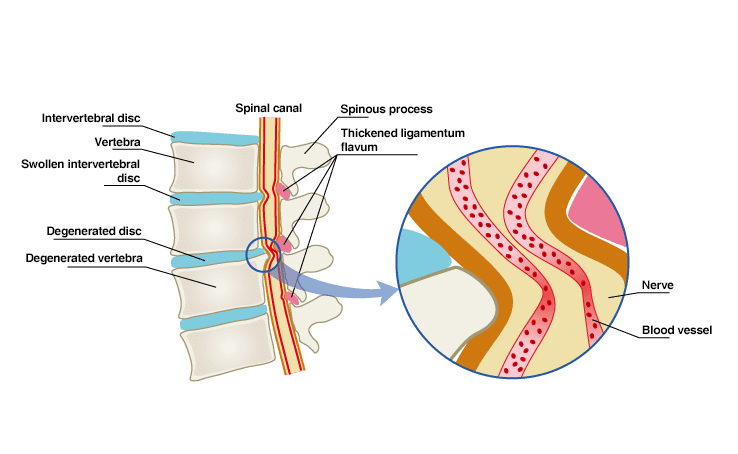Column What is Spinal Canal Stenosis? A Back Pain Specialist Explains the Symptoms, Causes, and Solutions For This Medical Condition
What is spinal canal stenosis?
Spinal canal stenosis is a condition in which the spinal canal (the tunnel through which the spine passes to protect the spinal cord) is compressed and narrows (stenosis) due to various factors.
The following images will give you a better idea of the structure of the spine and spinal canal, and of spinal canal stenosis:

Symptoms that may lead to suspecting spinal canal stenosis
The two most common symptoms of spinal canal stenosis are:
① Intermittent claudication
While walking, the legs gradually become sluggish, numb, or lose strength, making it impossible to walk, but after a short rest, one is able to walk again. Another characteristic that if you walk with your trunk bent down, you will be able to walk for a relatively long time.
② Sciatica
Symptoms often appear in the buttocks and thighs from the waist down, and are characterized by sharp, electric-like pain and numbness in the calves and toes, tightness in the calves, a cold or burning sensation, and dullness in the legs.
This is a common symptom of back pain in middle-aged and elderly people. In severe cases, the pain can make it difficult to walk or stand up from a chair.
If you are experiencing these symptoms, there is a real possibility that you suffer from spinal stenosis, and we recommend that you seek medical advice without delay.
Causes of Spinal Canal Stenosis
From a strictly medical point of view, there are 3 major causes for spinal stenosis:
- Pressure on the spinal canal due to deformed and protruding discs
- Deformation of the spine causing a compression of the spinal canal.
- Thickening of the ligamentum flavum, which in turn compresses the spinal canal.
The following image shows each of these cases for visualization:

As you can see, the compression of the spinal nerves causes numbness and pain.
At the same time, the following mechanisms may also be at work:
● Inflammation occurring when the nucleus pulposus components of the degenerated disc comes in contact with the spinal cord.
● Inflammation of the intervertebral joints due to the strain placed on them to support the distortion of the spine.
● Inflammation of the fascia and muscles of the back as they strain to support the distortion of the spine.
Diagnosis of spinal stenosis
As all the above-mentioned causes of spinal stenosis can be observed on MRI images, it is the best way to diagnose the condition.
Of course, a thorough consultation with the patient is also an important prerequisite to define the symptoms, pain, and numbness.
Improvement methods for spinal canal stenosis
There are four major methods of improvement:
Please refer to the following brief explanation of each method:
1. Conservative therapy
This is the first go to treatment proposed by any medical institution. Specifically, the following types of treatment are suggested:
- Exercise therapy (rehabilitation)
- Nerve block injections
- Drug therapy
- Orthotics, such as wearing a corset.
- Heat therapy
I will discuss the details of each of these treatments and our views on them in a subsequent post.
2. Surgery
The following surgical procedures are available for spinal stenosis.
Surgery is often proposed when a patient’s condition is expected to improve, and after 3 to 6 months of conservative treatment.
Vertebroplasty:
- Lumbar vertebroplasty
- Lumbar spinous process longitudinal split laminectomy
- Endoscopic lumbar discectomy
- Complete endoscopic lumbar discectomy
Fusion:
- Minimally invasive transforaminal intervertebral fusion
- Minimally invasive lateral spinal fusion
- Posterior lumbar intervertebral fusion
- Endoscopic lumbar interbody fusion
Spinal canal enlargement:
- Endoscopic spinal canal enlargement
- Percutaneous endoscopic spinal canal enlargement
The advantage of surgery is that it physically removes or fuses the causative site of the problem, so there is a high probability that symptoms will improve in the short term.
However, since the root cause of spinal canal stenosis is damage to the intervertebral disc, it is our belief that a surgery that merely removes the deformed disc that is pressing on the spinal canal and replace it with what is called a cage (which is completely different in nature from a disc), has a high possibility of recurrence in the long run.
3. Advanced medical treatment
A treatment method that repairs and regenerates the intervertebral disc, which is the root cause of spinal stenosis.
The Cellgel method
The Cellgel method is an advanced back pain treatment method that our clinic (ILC International Lumbago Clinic Tokyo) was the first to introduce and provide in Japan.
Click here for the link to the detailed page of the Cellgel method:
The Cellgel method at International Lumbago Clinic Tokyo
4. Other treatment methods
Other treatments are said to be effective to some extent, but so far there is little medical evidence to support that.
- Massages
- Chiropractic sessions
- Acupuncture
Written by the Administrative Director at ILC International Lumbago Clinic Tokyo



